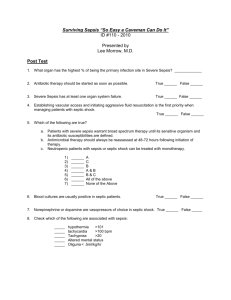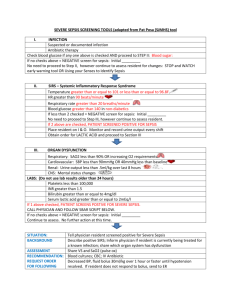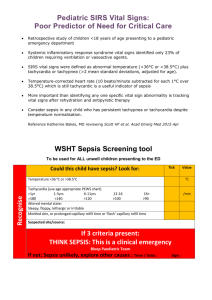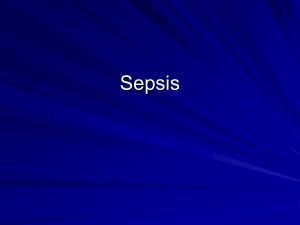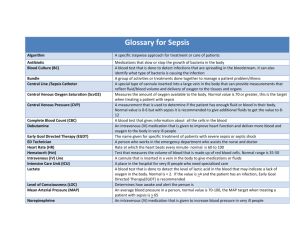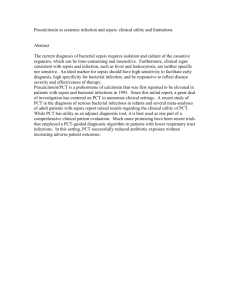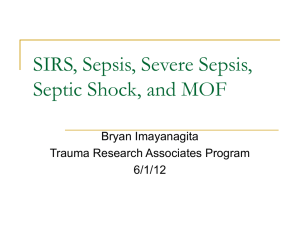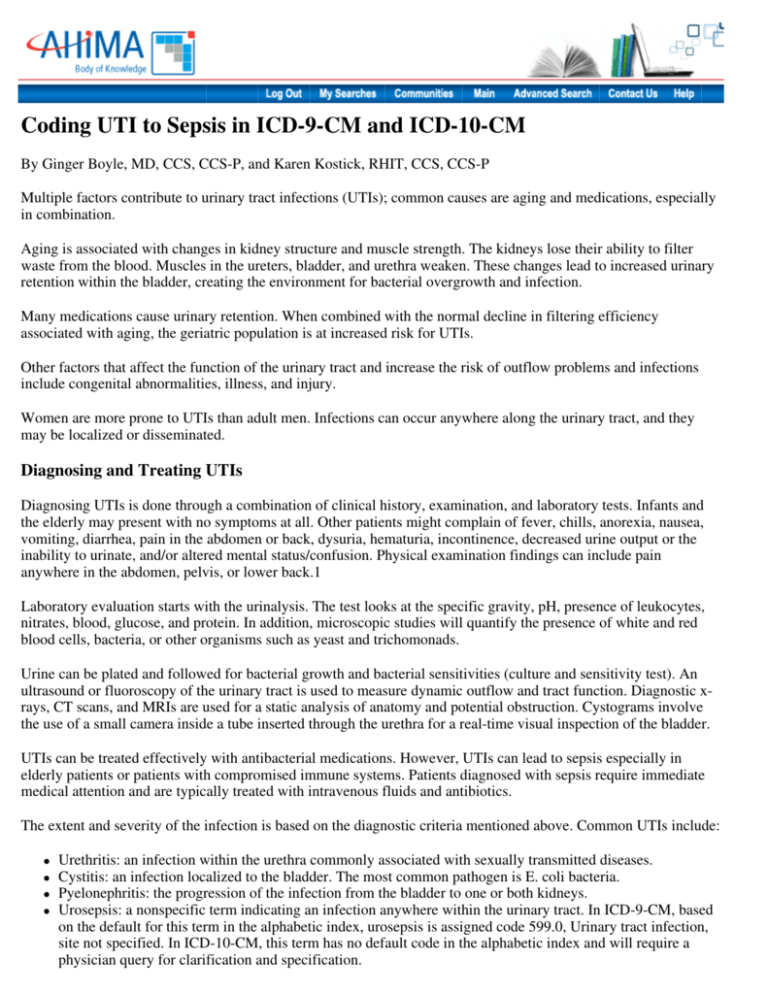
Coding UTI to Sepsis in ICD-9-CM and ICD-10-CM
By Ginger Boyle, MD, CCS, CCS-P, and Karen Kostick, RHIT, CCS, CCS-P
Multiple factors contribute to urinary tract infections (UTIs); common causes are aging and medications, especially
in combination.
Aging is associated with changes in kidney structure and muscle strength. The kidneys lose their ability to filter
waste from the blood. Muscles in the ureters, bladder, and urethra weaken. These changes lead to increased urinary
retention within the bladder, creating the environment for bacterial overgrowth and infection.
Many medications cause urinary retention. When combined with the normal decline in filtering efficiency
associated with aging, the geriatric population is at increased risk for UTIs.
Other factors that affect the function of the urinary tract and increase the risk of outflow problems and infections
include congenital abnormalities, illness, and injury.
Women are more prone to UTIs than adult men. Infections can occur anywhere along the urinary tract, and they
may be localized or disseminated.
Diagnosing and Treating UTIs
Diagnosing UTIs is done through a combination of clinical history, examination, and laboratory tests. Infants and
the elderly may present with no symptoms at all. Other patients might complain of fever, chills, anorexia, nausea,
vomiting, diarrhea, pain in the abdomen or back, dysuria, hematuria, incontinence, decreased urine output or the
inability to urinate, and/or altered mental status/confusion. Physical examination findings can include pain
anywhere in the abdomen, pelvis, or lower back.1
Laboratory evaluation starts with the urinalysis. The test looks at the specific gravity, pH, presence of leukocytes,
nitrates, blood, glucose, and protein. In addition, microscopic studies will quantify the presence of white and red
blood cells, bacteria, or other organisms such as yeast and trichomonads.
Urine can be plated and followed for bacterial growth and bacterial sensitivities (culture and sensitivity test). An
ultrasound or fluoroscopy of the urinary tract is used to measure dynamic outflow and tract function. Diagnostic xrays, CT scans, and MRIs are used for a static analysis of anatomy and potential obstruction. Cystograms involve
the use of a small camera inside a tube inserted through the urethra for a real-time visual inspection of the bladder.
UTIs can be treated effectively with antibacterial medications. However, UTIs can lead to sepsis especially in
elderly patients or patients with compromised immune systems. Patients diagnosed with sepsis require immediate
medical attention and are typically treated with intravenous fluids and antibiotics.
The extent and severity of the infection is based on the diagnostic criteria mentioned above. Common UTIs include:
Urethritis: an infection within the urethra commonly associated with sexually transmitted diseases.
Cystitis: an infection localized to the bladder. The most common pathogen is E. coli bacteria.
Pyelonephritis: the progression of the infection from the bladder to one or both kidneys.
Urosepsis: a nonspecific term indicating an infection anywhere within the urinary tract. In ICD-9-CM, based
on the default for this term in the alphabetic index, urosepsis is assigned code 599.0, Urinary tract infection,
site not specified. In ICD-10-CM, this term has no default code in the alphabetic index and will require a
physician query for clarification and specification.
The table below outlines the differences in coding a hospital-acquired cystitis due to E. coli in ICD-9-CM and ICD10-CM.
Coding Hospital-Acquired Cystitis Due to E. Coli
The table below illustrates the differences in coding hospital-acquired cystitis due to E. coli in ICD-9CM and ICD-10-CM.
Codes Assigned
ICD-9-CM
ICD-10-CM
595.9, Cystitis, unspecified
N30.90, Cystitis, unspecified without
hematuria
041.4, E. coli
B96.2, E. coli
Y95, Nosocomial condition
Code
Comparisons
The site of infection code does
not specify the organism;
therefore an additional code for
the organism is assigned.
The cystitis code specfies without hematuria.
The site of infection code does not specify the
organism; therefore an additional code for the
organism is assigned.
An additional external cause of morbidity
code is assigned to reflect the nosocomially
acquired infection
Required
Documentation
Causative organism
Causative organism
Presence or absence of a hematuria
Whether the infection is nosocomial
UTI to Sepsis
In 1992 a consensus conference of the American College of Chest Physicians and the Society of Critical Care
Medicine established definitions of the different stages of sepsis. In 2001 these organizations and several other
societies revisited the definitions, which are summarized below.
Septicemia is diagnosed when there is systemic disease associated with the presence of pathological
microorganisms or toxins in the blood (e.g., bacteria, viruses, fungi, or other organisms). Management includes
observation for symptoms or complications and repeating lab tests at a later date to verify resolution.
Systemic inflammatory response syndrome (SIRS) is the systemic response to a variety of severe clinical insults.
SIRS is diagnosed when there is systemic response to infection, trauma, or burn. The clinical signs and symptoms a
physician may consider to diagnose SIRS include but are not limited to fever (core temperature above 38° C),
tachycardia (e.g., heart rate > 90 bpm), tachypnea (e.g., respiratory rate > 20 bpm or arterial blood gas with PaCO2
< 32 mm Hg), and leukocytosis (e.g., white blood count < 4,000 or > 12,000 cells/mm or > 10 percent immature
neutrophils).2 SIRS does not refer to the infection directly but to the body's response to an "insult." Management
includes fluids, orally (PO) or intravenously (IV).
Sepsis refers to the presence of both infection and a systemic inflammatory response. Sepsis is diagnosed when
SIRS is due to a presumed or confirmed infection. The diagnostic criteria a physician may consider to diagnose
sepsis include but are not litmited to the previously diagnosed SIRS signs and symptoms, altered mental status,
significant edema or positive fluid balance (20 mL/kg over 24 hours), hyperglycemia (plasma glucose 120 mg/dL
or 7.7 mmol/L) in the absence of diabetes, plasma C-reative protein (> 2 SD above the normal value), and plasma
procalcitonin (> 2 SD above the normal value).3
Sever sepsis is diangosed when sepsis is associated with organ dysfunction, hypotension, and hyperfusion. In adults
septic shock refers to a state of acute circulatory failure characterized by persistent arterial hypotension unexplained
by other causes. In 2008 the Society of Critical Care Medicine's Surviving Sepsis Campaign updated its guidelines
to promote awareness of sepsis and improve early diagnosis and treatment. The clinical management guidelines are
available at http://www.survivingsepsis.org/guidelines.
ICD-9-CM and ICD-10-CM Sepsis Coding
A 67-year-old woman presents to the emergency department with altered mental status and an episode of syncope at
home. During the interview, she was unable to recall the minutes prior to the syncope and the ride to the hospital.
She continued to be disoriented about the date and time and recent events.
Her temperature was 103°, blood pressure 88/50, pulse 102, and respirations 20. On exam, she had tenderness to
palpation on the left flank and left lower quadrant. Her white blood count was 12.2, with 33 percent bands, BUN
45, and Creatinine 1.97. Her admitting diagnoses were UTI, altered mental status, and probable severe sepsis.
She was started on IV fluids and trimethoprim/sulfamethoxizole (TMP/SMX). Overnight, clinical documentation
noted she required IV fluids for oliguria and dopamine for persistent hypotension. She continued to be febrile,
tachycardic, and confused for the first two full days after admission. Her urine culture returned with E. coli,
resistant to TMP/SMX. She was changed to IV ciprofloxacin, after which she improved rapidly.
Upon discharge, the physician documented the principal diagnosis as E. coli septicemia, with severe sepsis and
acute renal failure. The proper code assignment is shown in the table below.
Due to the complex nature of SIRS, sepsis, and severe sepsis, physician documentation is essential in accurate code
assignment. In some instances it may require a physician query prior to accurate code assignment.
Infections in the urinary tract, SIRS, sepsis, and severe sepsis can be coding challenges for all involved.
Maintaining a supportive relationship between coding professionals and physicians through ongoing
communication and clinical documentation improvement programs has proven beneficial to assist with such
challenges.
Working together helps ensure the physician documentation reflects the quality of patient care provided. Clinical
documentation that is precise and thorough can also provide a defense for regulatory compliance reviews, including
the Recovery Audit Contractor, and will contribute to a successful ICD-10-CM/PCS transition.
Coding E. Coli Septicemia with Severe Sepsis and Acute Renal Failure
The following table compares coding E. coli septicemia in ICD-9-CM and ICD-10-CM from the case
study of the 67-year-old woman.
ICD-9-CM
Codes Assigned
Code
Comparisons
ICD-10-CM
038.42, Septicemia due to E. coli A41.51, Sepsis due to E. coli
995.92, Severe sepsis
R65.20, Severe sepsis without septic shock
584.9, Acute kidney failure,
unspecified
N17.9, Acute kidney failure, unspecified
The severe sepsis code is located The term sepsis has replaced septicemia
in tabular list, chapter 17, "Injury throughout the tabular list, chapter 1, "Certain
and Poisoning."
Infectious and Parasitic Diseases."
Severe sepsis code is located in tabular list,
chapter 18, "Symptoms, Signs, and Abnormal
Clinical and Laboratory Findings." Severe
sepsis code specifies without shock.
Required
Documentation
The extent of the infection (i.e.,
sepsis, severe sepsis)
The extent of the infection (i.e., sepsis, severe
sepsis)
Severe sepsis: if the causal
organism is not documented,
code 038.9, Unspecified
septicemia, is assigned.
Sepsis: the underlying systemic infection. If
the type of infection or causal organism is not
documented, code A41.9, Sepsis unspecified,
is assigned.
The associated acute organ
dysfunction(s)
Severe sepsis: the underlying systemic
infection. If the causal organism is not
documented, code A41.9, Sepsis unspecified,
is assigned.
The associated acute organ dysfunction
Notes
1. National Kidney and Urologic Diseases Information Clearinghouse. "Your Urinary System and How It
Works." August 2007. Available online at http://kidney.niddk.nih.gov/kudiseases/pubs/yoururinary.
2. Bone, RC, RA Balk, FB Cerra, et al. "Definitions for Sepsis and Organ Failure and Guidelines for the Use of
Innovative Therapies in Sepsis." Chest 101 (1992): 1644–55. Available online at
http://chestjournal.chestpubs.org/content/101/6/1644.full.pdf.
3. Levy, MM, MP Fink, JC Marshall, et al. "2001 SCCM/ESICM/ACCP/ATS/SIS International Sepsis
Definitions Conference." Critical Care Medicine 31 (2003): 1250–56. Available online at
http://www.srlf.org/data/Upload/Consensus/pdf/293.pdf.
Resources
National Centers for Health Statistics. "ICD-10-CM Official Guidelines for Coding and Reporting 2010." Available
online at https://www.cms.gov/ICD10/Downloads/7_Guidelines10 cm2010.pdf.
National Centers for Health Statistics. "ICD-9-CM Official Guidelines for Coding and Reporting." Available online
at http://www.cdc.gov/nchs/data/icd9/icdguide09.pdf.
Ginger Boyle (gbboyle@srhs.com) is clinical faculty for the Spartanburg Family Medicine Residency Program and
an assistant professor with the South Carolina AHEC/MUSC School of Medicine. Karen Kostick
(karen.kostick@ahima.org) is a practice resources specialist at AHIMA.
Article citation:
Boyle, Ginger; Kostick, Karen. "Coding UTI to Sepsis in ICD-9-CM and ICD-10-CM." Journal
of AHIMA 82, no.3 (March 2011): 52-54.
Copyright ©2011 American Health Information Management Association. All rights reserved. All contents, including images and
graphics, on this Web site are copyrighted by AHIMA unless otherwise noted. You must obtain permission to reproduce any
information, graphics, or images from this site. You do not need to obtain permission to cite, reference, or briefly quote this material
as long as proper citation of the source of the information is made. Please contact Publications to obtain permission. Please include the
title and URL of the content you wish to reprint in your request.

